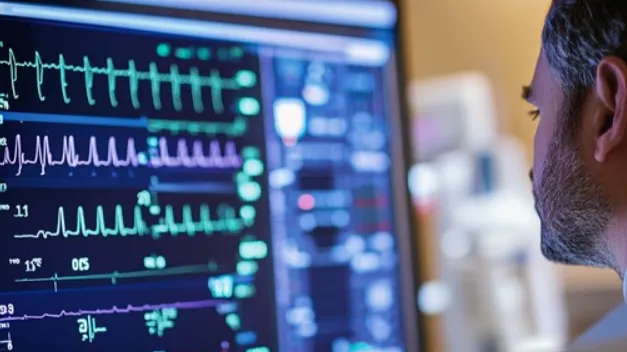Vital Signs: Fundamental Keys to Patient Stability
Date published: November 7, 2024

In the complex ecosystem of healthcare, the regular monitoring of vital signs often appears as a mundane routine. However, this seemingly ordinary task holds extraordinary significance in assessing a patient’s physiological stability. Vital signs—comprising body temperature, pulse rate, respiration rate, oxygen saturation, and blood pressure—are the basic indicators of health and are essential in detecting any deviations from the norm that could signify underlying medical conditions.
The Role of Vital Signs
in Healthcare
Vital signs are the body's way of communicating its state of wellness or distress. Regular monitoring provides healthcare professionals with critical data needed to make informed decisions about a patient's care. For instance, an irregular heart rate could indicate cardiac issues, while abnormal temperature readings might suggest an infection. Each measurement offers a piece of the puzzle that forms the complete picture of a patient’s health.
Clinical Reasoning and Clinical Judgment
Clinical reasoning and clinical judgment are crucial in analyzing a patient's vital signs, as they enable healthcare professionals to interpret data accurately and make informed decisions. These skills involve synthesizing information from various sources, recognizing patterns, and understanding the implications of subtle changes in vital signs. Early indicators of deterioration, such as slight variations in heart rate, blood pressure, or respiratory rate, can often be overlooked without keen clinical insight.
Effective clinical reasoning allows practitioners to connect these changes to potential underlying conditions, facilitating early intervention and improving patient outcomes. Clinical judgment helps prioritize actions and resources, ensuring that critical signs are not missed amidst the routine monitoring of vital signs. By honing these skills, healthcare providers can enhance their ability to detect early warning signs, ultimately leading to better patient care and reduced incidence of adverse events.
Why Understanding Vital Signs Matters
Understanding and interpreting vital signs is more than just a clinical task; it is a fundamental skill that empowers healthcare providers to preemptively address potential health crises. This knowledge is particularly vital for nurses and healthcare technicians who are often the first to assess a patient.
Early Detection of Deterioration
Regular monitoring of vital signs is crucial for identifying early signs of patient deterioration. For example, consistent high blood pressure readings can signal the onset of hypertension, enabling timely interventions to prevent more severe complications.
Evaluating Treatment Effectiveness
Tracking vital signs is essential for evaluating how well treatments are working. Variations in these signs can indicate whether a treatment is effective or if adjustments are necessary.
Informing Clinical Decisions
Vital signs are fundamental in guiding clinical decisions and interventions, especially in emergencies where rapid and accurate assessments can be life-saving.
Enhancing Patient Safety and Care Quality
Regular and accurate monitoring of vital signs is vital for patient safety. It ensures high-quality care by allowing healthcare providers to promptly address any changes in a patient’s condition.

Ventilation
Ventilation
is the movement of air in and out of the lungs, crucial for removing carbon dioxide, a byproduct of metabolism.
Proper ventilation
maintains stable carbon dioxide levels in the blood, preventing respiratory acidosis, which can lead to serious complications.
Observing the patient's breathing pattern and rate is essential to assess ventilation
Capnography can also be used to measure exhaled carbon dioxide levels, providing a more comprehensive view of respiratory function.
Conclusion: Elevating the Ordinary
The task of monitoring vital signs, though routine, is a cornerstone of effective healthcare delivery. It requires a deep understanding and appreciation of its role in maintaining patient health and safety. By elevating the importance of this ordinary task, healthcare providers can ensure that they are not only responding to medical conditions but are also proactively preventing the fallout of patient deterioration.
For more insights into patient safety and healthcare best practices, visit Dr. Julie Siemers' website: https://drjuliesiemers.com/.
Vital Signs: Fundamental Keys to Patient Stability
Date published: November 7, 2024

In the complex ecosystem of healthcare, the regular monitoring of vital signs often appears as a mundane routine. However, this seemingly ordinary task holds extraordinary significance in assessing a patient’s physiological stability. Vital signs—comprising body temperature, pulse rate, respiration rate, oxygen saturation, and blood pressure—are the basic indicators of health and are essential in detecting any deviations from the norm that could signify underlying medical conditions.
The Role of Vital Signs in Healthcare
Vital signs are the body's way of communicating its state of wellness or distress. Regular monitoring provides healthcare professionals with critical data needed to make informed decisions about a patient's care. For instance, an irregular heart rate could indicate cardiac issues, while abnormal temperature readings might suggest an infection. Each measurement offers a piece of the puzzle that forms the complete picture of a patient’s health.
Clinical Reasoning and Clinical Judgment
Clinical reasoning and clinical judgment are crucial in analyzing a patient's vital signs, as they enable healthcare professionals to interpret data accurately and make informed decisions. These skills involve synthesizing information from various sources, recognizing patterns, and understanding the implications of subtle changes in vital signs. Early indicators of deterioration, such as slight variations in heart rate, blood pressure, or respiratory rate, can often be overlooked without keen clinical insight.
Effective clinical reasoning allows practitioners to connect these changes to potential underlying conditions, facilitating early intervention and improving patient outcomes. Clinical judgment helps prioritize actions and resources, ensuring that critical signs are not missed amidst the routine monitoring of vital signs. By honing these skills, healthcare providers can enhance their ability to detect early warning signs, ultimately leading to better patient care and reduced incidence of adverse events.
Why Understanding Vital Signs Matters
Understanding and interpreting vital signs is more than just a clinical task; it is a fundamental skill that empowers healthcare providers to preemptively address potential health crises. This knowledge is particularly vital for nurses and healthcare technicians who are often the first to assess a patient.
Early Detection of Deterioration
Regular monitoring of vital signs is crucial for identifying early signs of patient deterioration. For example, consistent high blood pressure readings can signal the onset of hypertension, enabling timely interventions to prevent more severe complications.
Evaluating Treatment Effectiveness
Tracking vital signs is essential for evaluating how well treatments are working. Variations in these signs can indicate whether a treatment is effective or if adjustments are necessary.
Informing Clinical Decisions
Vital signs are fundamental in guiding clinical decisions and interventions, especially in emergencies where rapid and accurate assessments can be life-saving.
Enhancing Patient Safety and Care Quality
Regular and accurate monitoring of vital signs is vital for patient safety. It ensures high-quality care by allowing healthcare providers to promptly address any changes in a patient’s condition.

Ventilation
Ventilation
is the movement of air in and out of the lungs, crucial for removing carbon dioxide, a byproduct of metabolism.
Proper ventilation
maintains stable carbon dioxide levels in the blood, preventing respiratory acidosis, which can lead to serious complications.
Observing the patient's breathing pattern and rate is essential to assess ventilation
Capnography can also be used to measure exhaled carbon dioxide levels, providing a more comprehensive view of respiratory function.
Conclusion: Elevating the Ordinary
The task of monitoring vital signs, though routine, is a cornerstone of effective healthcare delivery. It requires a deep understanding and appreciation of its role in maintaining patient health and safety. By elevating the importance of this ordinary task, healthcare providers can ensure that they are not only responding to medical conditions but are also proactively preventing the fallout of patient deterioration.
For more insights into patient safety and healthcare best practices, visit Dr. Julie Siemers' website: https://drjuliesiemers.com/.
